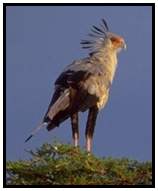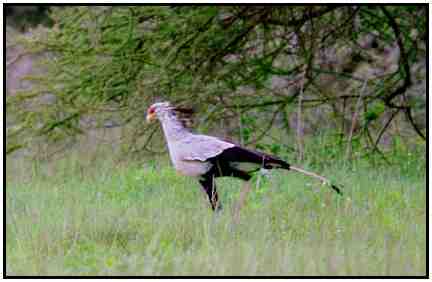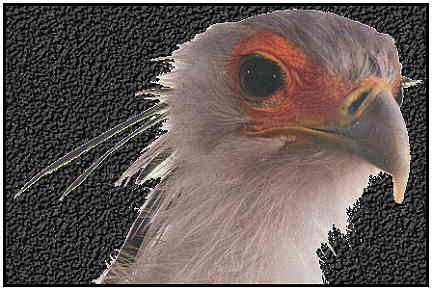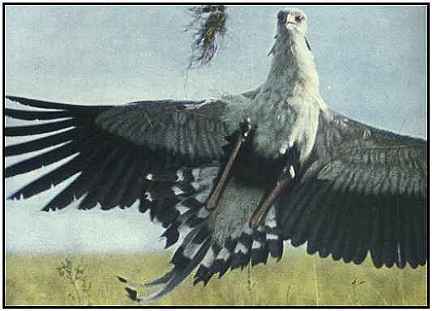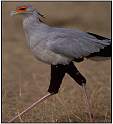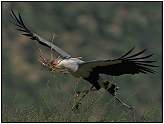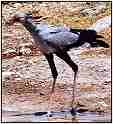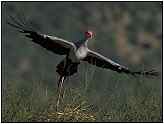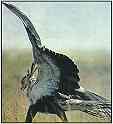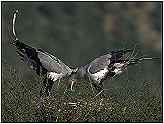Secretary BirdOrder: Falconiformes. Secretary Bird (Photograph Courtesy Gerald and Buff Corsi, California Academy of Sciences Copyright ©2000)Family: Sagittariidae Scientific Name: Sagittarius serpentarius Common Names: Secretary Bird. Conservation Status: Rare. Rescue & Recovery: Officially protected, though the reduction in this species continues. Geographical Range: Africa, south of the Sahara Desert. Habitat: Savannahs, steppes and plains. Occasionally found in very light bush areas. Physical Characteristics: The Secretary Bird is the only species in this family. It receives its common name from the Arabic saqu ettair which translates into French to mean hunter-bird (secrétaire). A fanciful story is that name originates from the pen-like quills which dangle off the bird's head; these are said to resemble the quills 18th century clerks carried tucked into their wigs. The scientific name of Sagittarius serpentarius refers both to the resemblance of the bird to an archer and also to its preference for snakes.
Secretary Bird (Photograph Courtesy of Ross Warner Photography Copyright ©2000)Secretary Birds do not have the grasping toes of other birds of prey; their toes are thick and blunt but armed with short, curved talons. Unlike other raptors they have long legs (the longest legs of any bird of prey), wings and tail. Usually seen on the ground hunting for food, these birds can fly well and soar in the same manner as vultures, though this they will only do when necessary. Even when pursued they rely upon their ability to walk quickly, rather than taking flight, but may spread their wings to aid in running. They are the only bird of prey with terrestrial habits and it is not unusual for a Secretary Bird to walk distances of up to twenty miles in a single day. The Secretary Bird is more than a metre long with plumage which is mostly white, having bands of black on the wings, tops of the legs and shaggy central tail feathers. The shape of the head, bald face and strong bill resemble the Caracara. Usually very quiet this bird emits hoarse croaks during mating. It may also make a mewing noise during the night. Secretary Bird (Copyright ©2000)Food: This bird's diet consists mostly of insects, lizards, small birds, eggs, hares, small tortoises (whole!) and rodents, but is a true specialist in the hunting and killing of snakes. It has developed some protection from snakebite and has scales on the legs which form a heavy plating. Their ability as snake catchers is such that these birds are often tamed and kept around farms for just this purpose. They can sometimes be seen performing what appears to be a dance; it was originally thought that this related to mating, however it has now been seen in situations where the bird is alone. It may simply be quick avoidance when a snake strikes, though this is yet to be proven. The most unusual item ever seen to be eaten by a Secretary Bird was a golf ball. Secretary Birds spend a great deal of time on the ground walking around and searching for prey. When hunting they spread their head feathers and will sometimes stamp vigorously, probably to flush out a potential meal. Small animals are simply picked up and swallowed, but larger ones like the snakes, are killed by stamping, or by grabbing the unfortunate victim and beating it to death on the ground. Stamping involves using amazing accuracy to impact the short rear talon with the skull of a likely meal. Prey may also be tossed into the air a number of times to stun it. They are opportunistic birds and gather at recently burnt out areas where prey are often injured and without plant cover. Though not a social bird, they often hunt in small groups or pairs, and keep in contact by hooting. In captivity this species is difficult to breed successfully, but those few captive-raised birds are usually fed on day-old chicks.
Secretary Bird (Photograph Copyright ©1969)Reproduction: During mating season there is heavy competition between the males, with birds doing acrobatic flights, climbing high into the sky, then suddenly dropping down. Once paired up Secretary Birds are devoted and remain together for life. Each year they return to the same nest repairing and expanding it with the addition of more sticks or grass. Nests with a diameter of two metres are not uncommon, however they are not easily spotted among the forks of trees, (often at the top of an acacia). The two, occasionally three, white eggs are incubated by the female and take about 45-50 days to hatch and the young are fed a diet of small mammals via regurgitation. After about eight weeks they are able to take flight. Thumbnails (Click For Full-Size Image):
|

